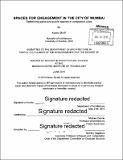Spaces for engagement in the city of Mumbai : rethinking parks and public spaces in congested cities
Author(s)
Shroff, Kairav (Kairav Rajiv)
DownloadFull printable version (40.80Mb)
Alternative title
Rethinking parks and public spaces in congested cities
Other Contributors
Massachusetts Institute of Technology. Department of Architecture.
Advisor
Michael Dennis.
Terms of use
Metadata
Show full item recordAbstract
Unplanned urbanization in Mumbai has left the city in a dense congested state with only 1.7m 2 of open space per person. The present dense living conditions also make it impossible to construct any large park or centrally accessible public space in the city. To construct a park the size of central park will require more than 100,000 people to be displaced and in a democratic country like India is an impossible solution. Therefore an alternate strategy to create public space is required for congested cities like Mumbai, where larger solutions are impossible. Mumbai has few planned public spaces in the form of parks, waterfronts, maidans and plazas but many more unplanned public spaces that exist all over the city. Almost three times as many people use the unplanned public spaces as compared to those using planned public spaces. Yet the focus is always on creating more planned public spaces because they can be easily quantified in terms of length, area or quantity, thus making it easy to justify. Unplanned public spaces on the other hand cannot be quantified and are always ignored during the planning process in spite of the immense social value they have. This thesis focuses on developing a framework to understand the conditions that activate unplanned public spaces and on designing a system that can enhance these spaces to act as social spaces that provide relief. Furthermore by networking these spaces together, we can then create a system of smaller social spaces that add up to form a larger public realm.
Description
Thesis: S.M., Massachusetts Institute of Technology, Department of Architecture, 2015. Cataloged from PDF version of thesis. Includes bibliographical references (pages 170-171).
Date issued
2015Department
Massachusetts Institute of Technology. Department of ArchitecturePublisher
Massachusetts Institute of Technology
Keywords
Architecture.